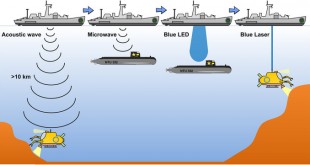Many types of sensors have been proposed for detection of small targets such as tanks and trucks including passive infrared imaging sensors and active Radars. Passive sensing systems, for many types of targets, especially airborne ones, use target motion as a cue for the target detection. However, for stationary small targets the separation of small targets from background clutter is a challenging problem.
Polarimetric sensors provide another passive sensing modality that can used for detecting military targets on the ground by means of an autonomous polarimetric sensor onboard a high altitude air or space platform. Polarization is a primary characteristic of electromagnetic wave. Polarization is another field of the light except the intensity, wavelength, and coherence. Polarization can indicate the different attributions that decided by objects, such as surface features, roughness, shading, shape and so on.
Polarization Imaging is a useful complement to traditional intensity and spectral imaging methods with great potential in many application fields. In the future war, the advantages of polarization are significant for target detection and recognition in the increasingly complicated battlefield environment. polarization thermal sensor has ability to detect manmade objects even when there is little or no thermal contrast, or when the object is obscured by clutter or vegetation
In order to select a specific polarization of light, polarizers are used. Vector polarizers are a light filtering technology hidden behind the operation of many optical systems. They can be found, for instance, in sunglasses, LCD screens, microscopes, microprocessors, laser machining and more.
Polarizers can be broadly divided into reflective, dichroic, and birefringent polarizers. Reflective polarizers transmit the desired polarization while reflecting the rest. Dichroic polarizers absorb a specific polarization of light, transmitting the rest; modern nanoparticle polarizers are dichroic polarizers. Birefringent polarizers rely on the dependence of the refractive index on the polarization of light. Different polarizations will refract at different angles and this can be used to select certain polarizations of light.
An innovative new light polarizer has been designed that efficiently tailors polarized light
Optical physicists from Nanjing and Nankai University, China, and the University of Central Florida, U.S., published details of their new vector polarizer design this week in APL Photonics, from AIP Publishing. The newly proposed design is a major advance in polarization technology because it enables flexible filtering of a wide range of light sources and generation of new light states.
Wang’s group achieved a design that can tailor light intensity, phase and polarization. “The vector polarizer can significantly improve the generation efficiency of vector light beam and may be conducive to achieving a high-performance vector laser.”
The physicists increased polarizer effciency and flexibility by using a new liquid-crystal-based design that relies on birefringence, where specific polarizations are filtered based on their refractive indexes. Wang explained that they customized the orientation of liquid crystal molecules by using stringent photo-alignment techniques. They determined the dichroic dye film structure within the thin glass compartment before adding the liquid crystal.
The new vector polarizers also feature manufacturing advantages. “They are flexibly designed and easily fabricated, and have the advantages of the large-size complex structures and the broadband [light waves] operation,” Wang said. “However, the vector polarizer we proposed still needs some improvements. For example, we need to improve its alignment quality, i.e., the quality of generated light beams. We also need to improve the spatial resolution for controlling the orientation of liquid crystal molecules.”
Wang is particularly excited about this vector polarizer’s ability to generate new polarized light states, which he hopes to use in developing novel applications. As an example, entangled vector photon states could be used in developing technology for quantum communications.
References and resources also include:
https://www.eurekalert.org/pub_releases/2017-12/aiop-ail121317.php
 International Defense Security & Technology Your trusted Source for News, Research and Analysis
International Defense Security & Technology Your trusted Source for News, Research and Analysis

